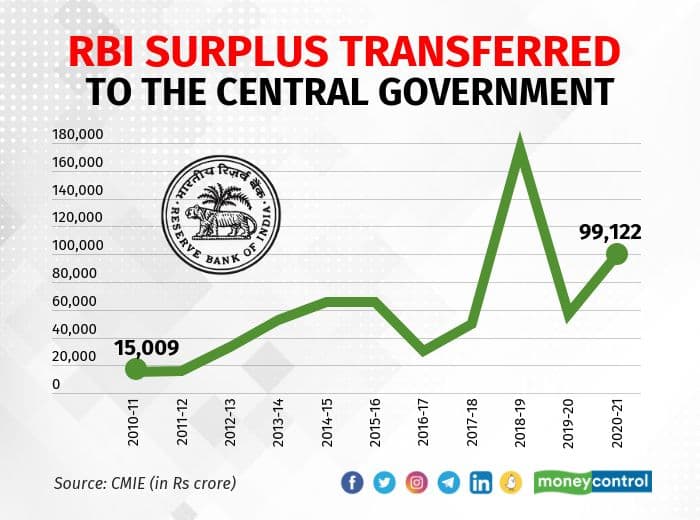To give a comparison, last year, the RBI transferred only 44 percent of its surplus, Rs 57,128 crore, to the government, the lowest transfer in the past seven years.
The Reserve Bank of India (RBI) on May 21 said it will transfer a surplus of Rs 99,122 crore to the government for the nine-month accounting period ended March 31, the central bank has said. As the manager of its finances, every year the RBI pays a dividend to the government to help with the finances from its surplus or profit.
To give a comparison, last year, the RBI transferred only 44 percent of its surplus, Rs 57,128 crore, to the government, the lowest transfer in the past seven years. In 2019, RBI transferred Rs 1,23,414 crore surplus to the government. This time, the government had estimated Rs 45,000 crore dividend from the central bank.

How did the figure go up so sharply this year?
One needs to wait for more details on the sources of the central bank’s income, economists have cited certain possibilities on the higher income. ” “It could be due to large OMOs adding to G-sec holdings and forex transactions. I can’t think of any other reasons,” said Madan Sabnavis, chief economist at CARE Ratings. OMOs are open market operations under which the RBI buys or sells government bonds to manage liquidity in the system.
According to a note by Emkay Global, the jump could be possibly due to RBI’s forex operations, wherein even though it was a net forex buyer in FY21, the gross dollar sale was close to $85.2 billion for the relevant period of July, 2020 to March, 2021 compared with barely $20 billion in same period last year. According to Emkay, this could have helped in realising decent profits on the forex sale transactions. “Separately, It also needs to be seen if they used the revaluation reserves in order to pay higher dividend, though it looks to be unlikely,” Emkay said in the note.
Barclays, in a note said, the upside surprise could have been driven by increased returns from domestic assets and changes in accounting practices by the central bank. “The RBI recently allowed itself to book profits on its forex transactions from a weighted average cost perspective. Our estimates show that this move could have helped the central bank boost yields on its foreign asset holdings. Further, increased holdings of domestic government securities likely further amplified the central bank’s income for the year,” said Barclays economists.
Adity Nayar, Chief economist of ICRA Ltd said: “The rise in the RBI’s surplus could be linked to higher interest income following the expansion in its holdings of G-sec related to OMOs and TLTROs, as well as the sizeable rise in forex reserves,” Nayar said. TLTROs refer to targeted long-term repo operations used to infuse cash in the banking system for on-lending to specific sectors.
The RBI, founded in 1934, operates according to the Reserve Bank of India Act of 1934. The act mandates that profits made by the central bank from its operations be sent to the Centre. “After making provision for bad and doubtful debts, depreciation in assets, contributions to staff and superannuation funds 2 [and for all other matters for which provision is to be made by or under this Act or which] are usually provided for by bankers, the balance of the profits shall be paid to the Central Government,” Section 47 of the RBI Act says.
The RBI also decided to maintain the contingency risk buffer at 5.5 percent. The decisions were taken at the 589th meeting of the Central Board of Directors of RBI held under the chairmanship of Governor Shaktikanta Das on May 21. The RBI is required to maintain a contingency risk buffer of 5.5-6.5 percent of its balance sheet.
“With the change in the Reserve Bank’s accounting year to April-March (earlier July-June), the Board discussed the working of the Reserve Bank of India during the transition period of nine months (July 2020-March 2021)… The Board also approved the transfer of Rs 99,122 crore as surplus to the Central Government for the accounting period of nine months ended March 31, 2021 (July 2020-March 2021),” RBI said.